The subject of vaccination is not strictly dichotomous with anti-vaxxers on one side and pro-vaxxers on the other. A vast number of the population is still undecided, and requires guidance to eventually decide their stance. More often than not, undecided fellows get highly entangled with anti-vaxxers, thereby fuelling the already dangerous anti-vax sentiments originating from the 1700s. This article focuses on these anti-vax views, shedding light on why this rhetoric prevails.
The debate over the use of vaccines has once again surged with the rapid development of the COVID-19 vaccines. With 7 vaccines in Phase III Clinical Trials, the promise remains that we may have a contender by the end of this year after all.
We have previously covered important aspects of the pandemic which you can view on our COVID-19 Resources page. These involve easy-to-follow articles on how vaccines work, the traditional types of vaccines and more specifically how some of the COVID-19 vaccines (the Moderna vaccine, Oxford University/AstraZeneca Vaccine, the vaccine in development by Sinovac, and the Novavax vaccine) in development work.
Since the rise of vaccine reporting, more people have taken advantage of the democratized flow of information online – taking in and sharing whatever they find on social media to be facts, which scientists know are undoubtedly fueled by fiction. If they are somewhat fictitious, why then does the anti-vax rhetoric prevail?
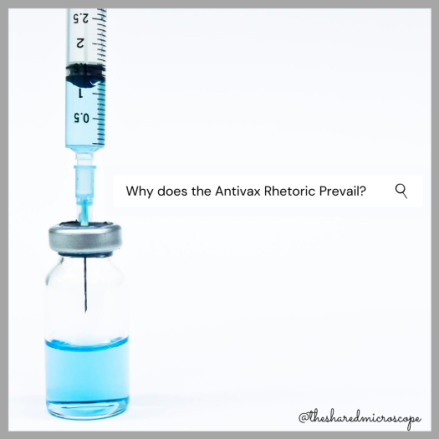
In this post, we aim to delve into why the anti-vax rhetoric prevails despite most media channels and scientists continuously promoting vaccine use. Below are some of the reasons anti-vax sentiments prevail, and why more people are easily recruited into the anti-vax agenda.
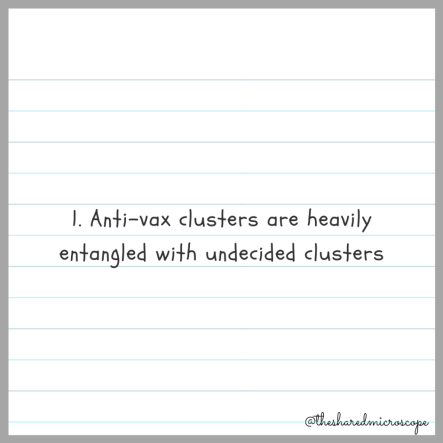
Anti-vaxxers staunchly oppose the use of vaccines, and are incredibly active at spreading misinformation. Their spread of misinformation is so effective that people who are undecided are now wavering more than they have ever done previously.
Anti-vax clusters are heavily entangled with undecided clusters
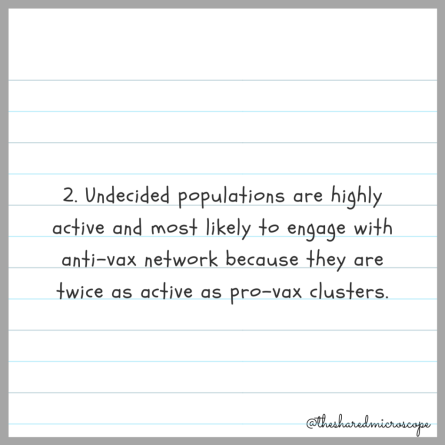
Because anti-vaxxers are actively online communicating their stance, chances are an undecided individual will first see lots of anti-vax content, whether or not they mean to actively find this content. And we all know, first impressions can be some-what permanent. I guess getting some pro-vax content out there will be a start!?
Undecided populations are highly active and most likely to engage with anti-vax networks because they are twice as active as pro-vax clusters.
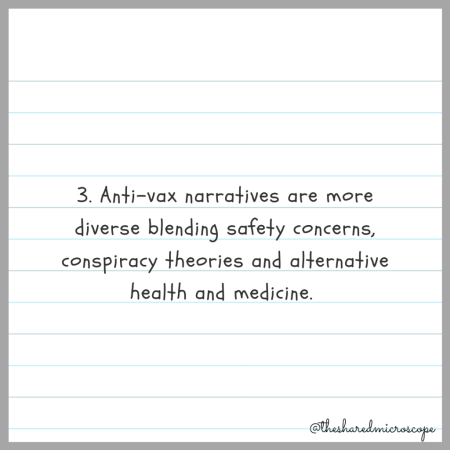
The narratives from the anti-vax community are diverse. These include incorrect references to cyborgs, 5G technology, embryonic stem cells, and also the fraudulent research by Andrew Wakefield about the MMR vaccine. For examples of some of the common anti-vax myths, please check out our guest post with Fancy Comma, LLC for the Seeking Science blog page, where we have debunked these myths.
Anti-vax narratives are more diverse blending safety concerns, conspiracy theories and alternative health and medicine

Compared to the different kinds of narratives from the anti-vax community, the pro-vax narratives are mono-thematic. As scientists, our most used narrative is about how a vaccine works and how Andrew Wakefield’s research is fraudulent. Simply put, our narrative is fact-based rather than based on emotion – perhaps why it is not as effective.
Pro-vax narratives are mono-thematic.

Although this may seem somewhat counter intuitive, large anti-vax clusters aren’t as much a problem as the medium clusters. This is because large organisations, governments, scientists, etc. focus their attention on larger groups. The small and medium groups are therefore able to spread faster by escaping detection and intervention.
Medium-sized anti-vax clusters grow the most because pro-vax clusters are distracted by larger anti-vax groups.
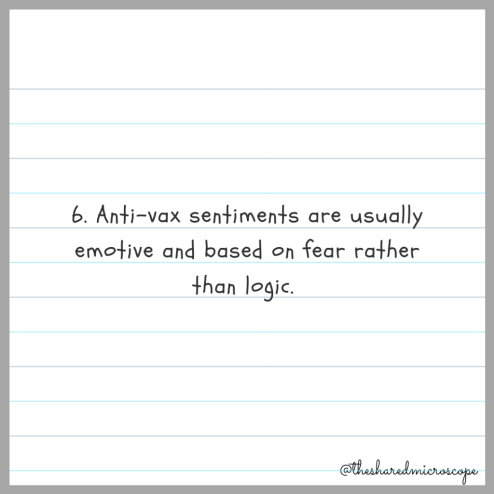
Most of the anti-vax sentiments come from a fear of the unknown. A lack of understanding of both science and technology probably leads to beliefs of cyborgs and mind-control. These sentiments may also arise from poorly understood science in science-fiction movies.
Anti-vax sentiments are usually emotive and based on fear rather than logic.
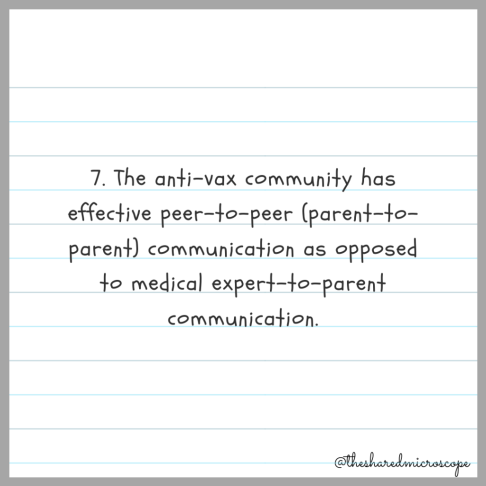
Most parents interact with other parents about their respective kids. They trust each other. Parents will therefore also take advice from each other; they see each other as peers and therefore communication between them is usually effective. This is different to communication between medical experts and parents, which may be effective when it comes to medication, but this is not always the case.
The anti-vax community has effective peer-to-peer (parent-to-parent) communications as opposed to medical expert-to-parent communication.
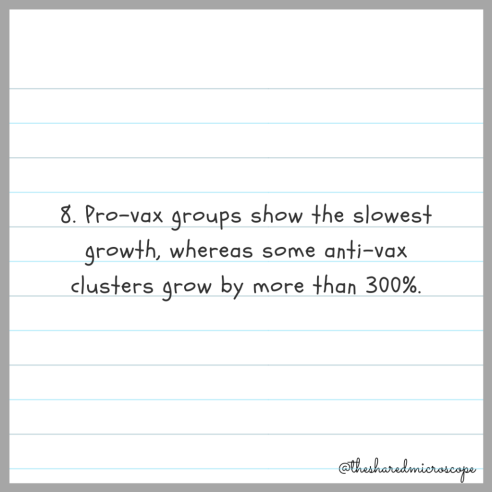
Due to the aforementioned reasons, anti-vax groups are able to recruit at higher numbers and they are therefore growing faster than pro-vax counterparts.
Pro-vax groups show the slowest growth, whereas some anti-vax clusters grow by more than 300%.
Although governments worldwide are focused on fast-tracking the COVID-19 vaccines in development, these efforts may go to waste if the anti-vax sentiments continue to persist at current rates.
The above reasons as to why the anti-vax rhetoric prevails are provided in a paper published in Nature by Johnson, N et al. (2020). This research studies millions of Facebook users and predicts that without any interventions, the anti-vax views will dominate in a decade.
To ensure that we can intervene at this stage, insights from this paper should be used to inform new policies and also to encourage communication of vaccine use.
Related posts:
 Covid-19: Let’s Get Handsy!
Covid-19: Let’s Get Handsy!
 [Newsletter] Round-Up of COVID-19 Vaccine Updates: Week Commencing September 28, 2020
[Newsletter] Round-Up of COVID-19 Vaccine Updates: Week Commencing September 28, 2020
 [Newsletter] Round-Up of COVID-19 Vaccine Updates: Week Commencing November 09, 2020
[Newsletter] Round-Up of COVID-19 Vaccine Updates: Week Commencing November 09, 2020
 [Newsletter] Round-Up of COVID-19 Vaccine Updates: Week Commencing November 16, 2020
[Newsletter] Round-Up of COVID-19 Vaccine Updates: Week Commencing November 16, 2020
 [Newsletter] Round-Up of COVID-19 Vaccine Updates: Week Commencing January 18, 2021
[Newsletter] Round-Up of COVID-19 Vaccine Updates: Week Commencing January 18, 2021
- Written by: Nidhi
- Posted on: September 1, 2020
- Category: COVID-19


0 comments
SciCommers Weigh in on How to Write about Science in a Pandemic – Fancy Comma, LLC
September 13, 2020 at 10:59 pm[…] the progress made towards putting the pandemic in the past. Nidhi Parekh has written about the dangers of the anti-vax rhetoric, and the need for improved science communication in the COVID-19 pandemic, on her […]
5 Experts Muse about the Future of COVID-19 – Fancy Comma, LLC
September 17, 2020 at 5:07 am[…] Piot also added in the Science interview that people unwilling to get a COVID-19 vaccine could hold back global efforts to end the pandemic. He noted, “Today […]
What Does Vaccine Efficacy Mean? – Fancy Comma, LLC
November 21, 2020 at 11:06 pm[…] each passing day as more promising news about the COVID-19 vaccines in development are released. Anti-vax rhetoric threatens to undermine the global efforts by spreading […]